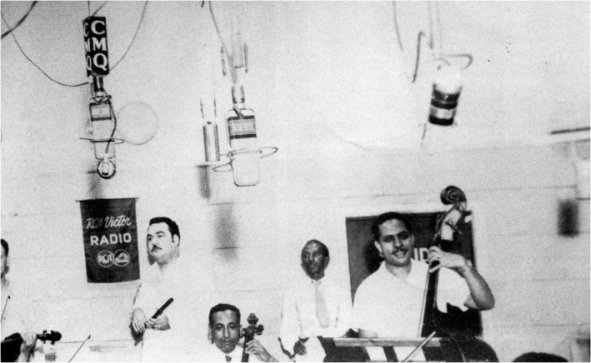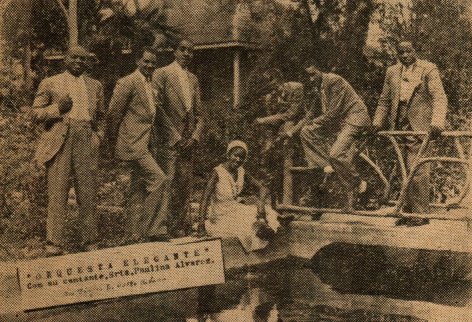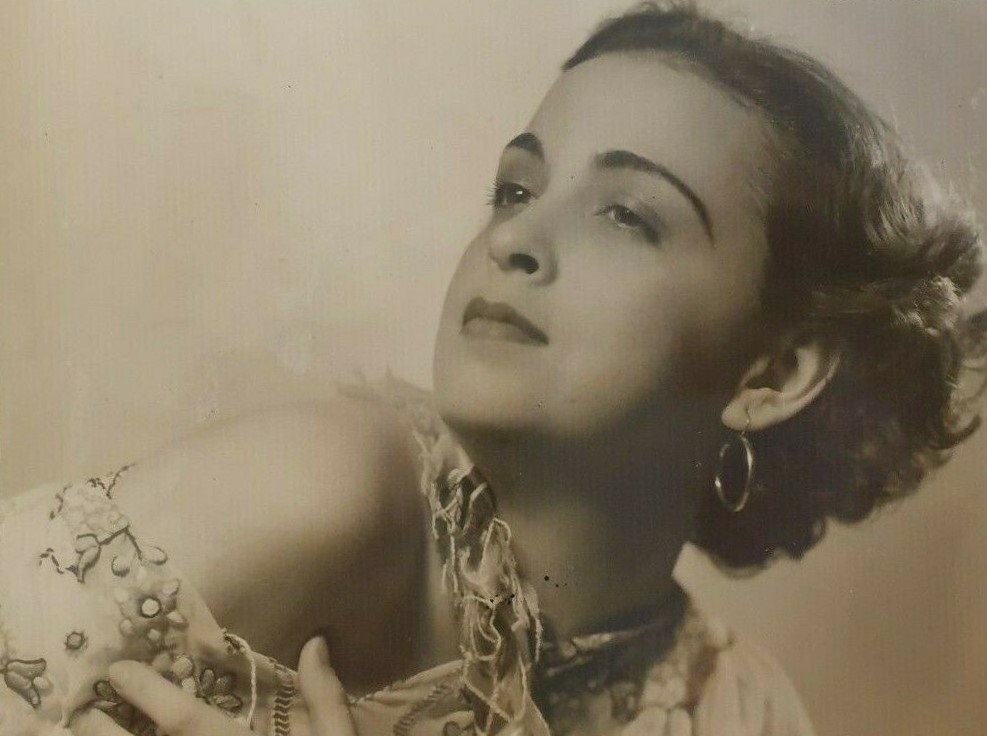|
EGREM
EGREM (Empresa de Grabaciones y Ediciones Musicales, Spanish for ''Enterprise of Recordings and Musical Editions'') is the national record label of Cuba. It is headquartered in Centro Habana, where its main record studios (''Estudios Areito'' 101 & 102) operate. It was founded in 1964 after the nationalization of the Cuban music industry, absorbing the assets of Panart. EGREM had a monopoly on music production activities from 1964 until the late 1980s when independent labels reemerged.Cubadisco: Cuba's premier music awards show Cuba Absolutely. April 2013. EGREM's archive comprises "the most extensive catalog of Cuban music in the world". Since 2002, EGREM has a commercial director, a public relations department and a we ... [...More Info...] [...Related Items...] OR: [Wikipedia] [Google] [Baidu] |
Areito (record Label)
Areito is a Cuban record label founded in 1964 as the primary imprint of EGREM, which is based in Havana. Areito is named after the recording studio from which the vast majority of its catalog stems, which in turn was named after the Taíno ritual of the same name. The record studio had established in 1944, originally named Panart studios and was associated with recording engineer Ramón Sabat's Panart Panart was one of the first and most successful independent record labels in Cuba, founded in 1944 by engineer Ramón Sabat. In 1961, its studios were seized by Fidel Castro's communist regime and the label was nationalized, becoming "Panart Nacio ... record label. The 1959 government nationalized the Cuban music industry, including the associated studio and record company in 1961. Since the 1960s, Areito/EGREM has been the main music company in Cuba, managing most of the recording, manufacture and distribution of albums, EPs and singles in the country. Areito's counterpart in eas ... [...More Info...] [...Related Items...] OR: [Wikipedia] [Google] [Baidu] |
Orquesta Aragón
Orquesta Aragón is a Cuban musical band formed on 30 September 1939, by Orestes Aragón Cantero in Cienfuegos, Cuba. The band originally had the name ''Ritmica 39'', then ''Ritmica Aragón'' before settling on its final form. Though they did not create the ''Cha-cha-cha'', they were arguably the best charanga in Cuba during the 1950s and 1960s. Their trade-marks included high-class instrumentalists playing in tight ensemble style, and rhythmical innovations which kept their sound up to date. Over the years they progressed from their start as a danzoneria to play a wider variety of styles, danzón, then cha-cha-cha, then onda-cha, pachanga and son fusions. They still perform today, based in Havana. History Originally, the orchestra consisted of eight musicians: Orestes Aragon (double bass), Filiberto Depestre (first violin), Hilario René González (second violin) Rufino Roque (piano), Efraín Loyola (flute), Orestes Varona (timbales), Noelio Morejon ( güiro) & Pablo Romay (voca ... [...More Info...] [...Related Items...] OR: [Wikipedia] [Google] [Baidu] |
Panart
Panart was one of the first and most successful independent record labels in Cuba, founded in 1944 by engineer Ramón Sabat. In 1961, its studios were seized by Fidel Castro's communist regime and the label was nationalized, becoming "Panart Nacionalizada", which shortly after was absorbed by EGREM. Together with RCA Victor's, Panart studios were the main recording studios in Cuba during the 1950s. Since the 1960s, they are known as the Areito studios, owned by EGREM. In addition, Panart acted as a distributor for Odeon, Musart, Sonora and Capitol Records. Its only sublabel, Sonoro, was established in 1949 and signed several trova acts such as Los Compadres. In 2016, Panart was acquired by Concord Bicycle Music (renamed Concord in 2019) as a part of its purchase of Musart. Within Concord, Panart is operated as an imprint of the historical reissue label Craft Recordings. History Origins and expansion After studying music, joining the army and obtaining a degree in engineering, ... [...More Info...] [...Related Items...] OR: [Wikipedia] [Google] [Baidu] |
Guillermo Barreto
Guillermo Barreto (August 11, 1929 – December 14, 1991) was a Cuban drummer and ''timbalero''. He was a major figure in the Cuban music scene for more than fifty years and one of the first drummers in Cuba to play Afro-Cuban jazz. Nicknames Like many Cuban musicians, Guillermo Barreto had several nicknames. He was usually credited as "Barretico" during the 1950s and 1960s. He was also known as "El Loro" (''The Parrot'') and "Pata de loro" (''Parrot leg'') "due to his constant chatter and parrotlike walk", a nickname given to him by Rita Montaner according to Paquito D'Rivera. Biography Early life and career Barreto was born in Havana on August 11, 1929. His father was Primo Barreto, a clarinetist who taught music to all of his children: Lita, Josefina, Estela, Alejandro "Coco", Roberto "Bobby", and Guillermo. As a young man, Guillermo became a skilled interpreter of Cuban pailas. In the 1940s, he was part of several big bands: the Cabaret Tropicana resident orchestra ... [...More Info...] [...Related Items...] OR: [Wikipedia] [Google] [Baidu] |
Cachao
Israel López Valdés (September 14, 1918 – March 22, 2008), better known as Cachao ( ), was a Cuban double bassist and composer. Cachao is widely known as the co-creator of the mambo and a master of the descarga (improvised jam sessions). Throughout his career he also performed and recorded in a variety of music styles ranging from classical music to salsa. An exile in the United States since the 1960s, he only achieved international fame following a career revival in the 1990s. Born into a family of musicians in Havana, Cachao and his older brother Orestes were the driving force behind one of Cuba's most prolific Charanga (Cuba), charangas, Arcaño y sus Maravillas. As members of the Maravillas, Cachao and Orestes pioneered a new form of ballroom music derived from the danzón, the danzón-mambo, which subsequently developed into an international genre, mambo. In the 1950s, Cachao became famous for popularizing improvised jam sessions known as descargas. He emigrated to Spa ... [...More Info...] [...Related Items...] OR: [Wikipedia] [Google] [Baidu] |
Cuban Music
The music of Cuba, including its instruments, performance, and dance, comprises a large set of unique traditions influenced mostly by west African and European (especially Spanish) music. Due to the syncretic nature of most of its genres, Cuban music is often considered one of the richest and most influential regional music in the world. For instance, the son cubano merges an adapted Spanish guitar (tres), melody, harmony, and lyrical traditions with Afro-Cuban percussion and rhythms. Almost nothing remains of the original native traditions, since the native population was exterminated in the 16th century. Since the 19th-century Cuban music has been hugely popular and influential throughout the world. It has been perhaps the most popular form of regional music since the introduction of recording technology. Cuban music has contributed to the development of a wide variety of genres and musical styles around the globe, most notably in Latin America, the Caribbean, West Africa, and Eu ... [...More Info...] [...Related Items...] OR: [Wikipedia] [Google] [Baidu] |
Paulina Álvarez
Raimunda Paula Peña Álvarez (June 29, 1912 – July 22, 1965), better known as Paulina Álvarez, was a renowned Cuban singer of danzonetes (sung danzones). She became the leading exponent of the genre during the 1930s, being nicknamed La Emperatriz del Danzonete (The Empress of the Danzonete). Her greatest hit was the song "Rompiendo la rutina", the first danzonete, composed by Aniceto Díaz in 1929. In 1960 she recorded her only LP record. Life and career Early life and career Paulina Álvarez was born Raimunda Paula Peña Álvarez on June 29, 1912 in Cienfuegos, Cuba. By the time she was eight or nine years old she was singing at parties and school functions. In 1926, at age 14, her family moved to Havana, where she started her professional singing career in societies, theatres and radio shows. She sang boleros and canciones, but quickly became specialized in a new style of sung danzón influenced by the son cubano called danzonete. In 1931 she became the singer for Orquesta ... [...More Info...] [...Related Items...] OR: [Wikipedia] [Google] [Baidu] |
Barbarito Díez
Barbarito Díez (December 4, 1909 – May 6, 1995) was a Cuban singer who specialized in danzón.Orovio, Helio (2004). ''Cuban Music from A to Z-CL''. Duke University Press Books. . He began his career as the singer for Graciano Gómez and Isaac Oviedo's son group, before joining Antonio María Romeu's orchestra. As the lead vocalist for Romeu's ensemble for 20 years, he established himself as one of the main exponents of the sung danzón. He continued singing with his own charanga, as well as other groups, for another 30 years. He also toured and recorded in Venezuela and Puerto Rico before retiring in the early 1990s, when complications from diabetes prevented him from performing and eventually resulted in his death in 1995. A naturally-gifted tenor, he was known for his sense of rhythm, correct diction and romantic style. Early life Bárbaro Díez Junco was born on December 4, 1909, in a sugar cane mill located in the small settlement of Bolondrón in Matanzas Provinc ... [...More Info...] [...Related Items...] OR: [Wikipedia] [Google] [Baidu] |
Felipe Dulzaides
__FORCETOC__ Felipe Dulzaides (born in Cuba, February 23, 1965) is a Cuban-born American contemporary artist. His practice includes installation, photography, video, drawing, sculpture and performance. Two important cities of reference of his works are San Francisco, California and Havana, Cuba. Family and education Felipe Dulzaides was born in Havana during the early period of the Cuban revolution, a time characterized by collective hope and enthusiasm. He is the son of an influential musician (they share the same name) and a kindergarten teacher. His father played an important role in the development of jazz in Cuba. His family also includes the ''Origenes'' group poets Eliseo Diego, Fina Garcia-Marruz and Cintio Vitier. In the mid 1980s Dulzaides attended the dramatic arts program of the Instituto Superior de Arte (ISA). As a student he became interested in the concepts of Jerzy Grotowski expressed on his book ''Towards a Poor Theater.'' Furthermore, he focused his studies ... [...More Info...] [...Related Items...] OR: [Wikipedia] [Google] [Baidu] |
Hilario Durán
Hilario Durán (born 1953, Havana) is a Cuban-Canadian jazz pianist. Durán studied at ''Conservatorio "Amadeo Roldán"'' Amadeo Roldan Music Institute in Havana, studying tumbao with Evaristo Aparicio, composition and conducting from German Pifferrer, and orchestration from Guillermo Barreto. He formed a group in the 1970s called Los D'Siempre, which melded traditional Cuban elements with those of modern jazz. He joined Arturo Sandoval's band from 1981 to 1990. He also worked with Dizzy Gillespie's United Nation Orchestra and Michel Legrand. He formed a new group, Perspectiva, in 1990, and toured Central America and Europe. From 1995 he worked as a solo artist in Toronto, Canada, and has collaborated over the course of his career with Tata Güines, Changuito, Horacio "El Negro" Hernandez, Jorge Reyes, Roberto Occhipinti, Larry Cramer, John Patitucci, Michael Brecker, Regina Carter, Dave Valentin, Juan Pablo Torres, John Benitez, Dafnis Prieto, Hugh Marsh, Carlos "Patato" Va ... [...More Info...] [...Related Items...] OR: [Wikipedia] [Google] [Baidu] |
Los Bucaneros
LOS, or Los, or LoS may refer to: Science and technology * Length of stay, the duration of a single episode of hospitalisation * Level of service, a measure used by traffic engineers * Level of significance, a measure of statistical significance * Line-of-sight (other) * LineageOS, a free and open-source operating system for smartphones and tablet computers * Loss of signal ** Fading **End of pass (spaceflight) * Loss of significance, undesirable effect in calculations using floating-point arithmetic Medicine and biology * Lipooligosaccharide, a bacterial lipopolysaccharide with a low-molecular-weight * Lower oesophageal sphincter Arts and entertainment * ''The Land of Stories'', a series of children's novels by Chris Colfer * Los, or the Crimson King, a character in Stephen King's novels * Los (band), a British indie rock band from 2008 to 2011 * Los (Blake), a character in William Blake's poetry * Los (rapper) (born 1982), stage name of American rapper C ... [...More Info...] [...Related Items...] OR: [Wikipedia] [Google] [Baidu] |
Esther Borja
Esther Borja Lima (5 December 1913 – 28 December 2013) was a Cuban operatic soprano and actress. Havana-born Esther Borja Lima was trained in solfége and music theory by Juan Elósegui, and in singing by Rubén Lepchutz. She graduated as a teacher in 1934, and began her career in 1935; that year she performed, with Ernesto Lecuona on piano, at the National Theatre (now the ''Gran Teatro de La Habana''), and at the ''Auditorium Amadeo Roldán''. The same year she sang the waltz ''Damisela encantadora'' in the operetta ''Lola Cruz'' by Lecuona. Her voice was described as a "beautiful mezzo-soprano with clear diction and a good feel for melody". At the time Borja started her career, and for years after, Rita Montaner was the leading stage musical star in Cuba. However, Montaner (who was also a fine pianist) gradually shifted her career from operatic-style singing towards Afro-Cuban character roles and films, and then began some remarkable radio shows with biting humour and politi ... [...More Info...] [...Related Items...] OR: [Wikipedia] [Google] [Baidu] |

.jpg)


